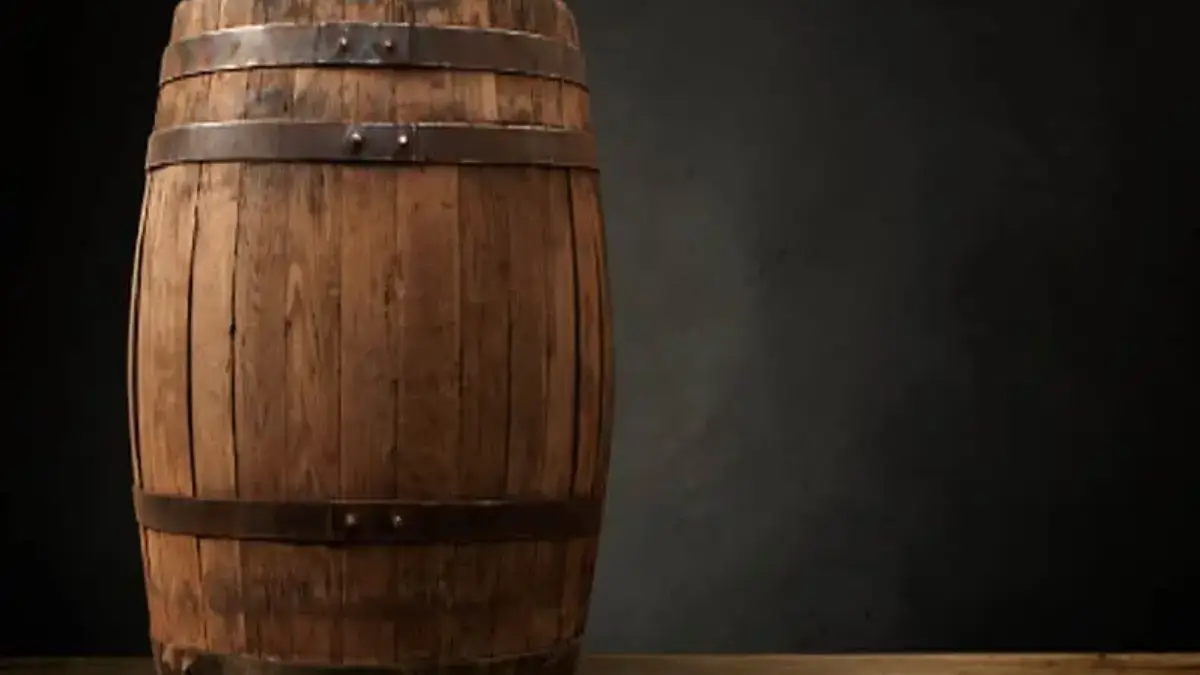
Imagine sitting in a cozy vineyard on a warm, sunny day, sipping a glass of your favorite wine. Have you ever wondered about the magic behind that rich and flavorful taste in your glass? Oak barrels are one of the key tools of a winemaker, acting both as storage vessels and adding subtle flavor nuances and soft tannins to the wine made in barrels. Oak is typically the material used to construct barrels; chestnut, beech, and acacia may also be utilized. So, grab your corkscrew and join us as we explore the oaky secrets behind your favorite wine.
Oak, renowned for its qualities in imparting unique flavors and characteristics to wines, is a primary choice for crafting staves in barrel production. Oak trees from regions like America, France, and Hungary are strategically grown in forests with managed planting density, and efforts are made to maintain straight branches to optimize production per tree.
The process of creating barrels involves steaming, cutting, and utilizing various tools to shape the staves into the desired barrel form. Subsequently, the barrel is toasted or seasoned with Sodium Bisulfite before being filled with wine for the aging process. Each barrel requires several years for the wine to fully mature and develop the desired flavors and complexities, making the oak barrel an integral element in the art and science of winemaking.
1. French Oak
Oak from both Europe and America is often utilized for wine-aging purposes. Different wood species and regions play a role in how well the barrel interacts with specific wines depending on species, tightness of grain tightness, amount of toasting depth, etc., all contribute to how a barrel interacts with certain wines being aged inside them – all contribute something that oak alone cannot do when alone!
Quercus petraea and Quercus robur are fundamental species utilized in the crafting of French oak barrels, known for enhancing the flavors and aromas of wines. These oak varieties flourish in dense forests where they can grow tall, straight trunks, ensuring high-quality wood for barrel production. The regions of Burgundy, Cognac, and Limousin in France are particularly renowned for producing high-grade oak, and the barrels made from the oak sourced from these regions’ forests are highly esteemed in the winemaking industry. The unique characteristics of French oak play a pivotal role in the aging and flavor development of wines, making it a preferred choice for many winemakers.
Sessile or pedunculate oak has coarser graining with differing balance of aromatic compounds than quadruplicate oak; more astringent and bitter characteristics come into play than with quadruplicate oak.
Vintners choose oak for their wines based on numerous considerations, such as its influence on the wine itself, aromas it will contribute, and any potential astringency or bitterness it will impart. Some vignerons prefer used wine barrels with oaky flavors that add Sherry-esque complexity and nutty notes, while others may opt for new barrels with more fruity and pure aromas.
To produce high-quality staves for winemaking, oak trees need to be cultivated in dense forests adhering to specific planting standards, ensuring optimal height and straightness of the trees. This careful cultivation results in staves that meet the desired quality criteria. Moreover, in the case of French oak, the wood undergoes a crucial aging process outdoors for a minimum of two years prior to use. This aging duration is essential for eliminating unwanted components from the wood’s structure, enhancing its suitability for winemaking. However, this meticulous aging process significantly escalates production costs.
Given the stringent measures and the associated cost considerations, French oak is primarily reserved for premium wines and expensive spirits. The oak’s unique properties, acquired through these precise procedures, contribute to the elevated quality and distinct flavors of the final product, justifying its usage in the production of high-end beverages.

American Oak
Oak barrels play an indispensable part in wine production as they add important flavor compounds that diffuse into wines to produce distinctive aromas and flavors such as vanilla, coconut, hazelnut, and spice. There are numerous factors that influence this interaction between oak and wine, such as species type, origin region, forest it comes from, duration spent outdoors, and seasoning period (seasoning time, level of toasting, barrel size, etc.).
American oak, sourced from wider and irregularly shaped trees, differs in characteristics from its European counterparts. These trees are less dense and more permeable, making them suitable for sawing instead of splitting. This approach helps reduce production costs and optimize yield from each tree. The permeability of American oak allows for faster extraction of flavors and compounds from the wood, making it an ideal material choice for shorter maturation periods, typically ranging from six to ten months. The distinct properties of American oak contribute unique flavors and aromas to the aging beverage, influencing the final taste profile and distinguishing it from wines aged in European oak barrels.
American oak is often considered more versatile and less costly than French Oak, making it more cost-effective. Quercus alba is the most prevalent species found throughout the U.S., with the maximum number of used barrels for sale coming from Minnesota, Missouri, and Wisconsin. American oak is prized among winemakers in Rioja and Australia due to its full, rich flavors of coconut.
American oak offers several advantages over European varieties, chief among them its thicker xyloses, which allow staves to be sawn (not split) without losing watertight integrity, leading to faster barrel production times at reduced costs. Furthermore, American oak boasts lower evaporation rates, meaning less frequent top-ups are necessary and creating more stable environments in which wine ages more successfully.
American Oak exhibits considerable variability in quality due to several influencing factors. The source forest and region of origin play a significant role, influencing the characteristics of the wood. Additionally, the toasting level during the barrel-making process contributes to the final flavor and aroma profile. The barrel’s volume and the number of vanillins introduced during toasting are crucial considerations as well. More vanillins can impart spicy or smoky notes to the aging beverage, providing a spectrum of flavors for winemakers to choose from.
The amount and duration of toasting can vary widely based on individual winemakers and their preferred style of winemaking. This diversity in factors and the ability to tailor the toasting process to specific preferences allow winemakers to craft wines with distinct characteristics, adding to the versatility and appeal of American Oak in the winemaking industry.
Hungarian Oak
Hungarian oak has become an increasingly popular barrel choice among winemakers in recent years, used for all styles from Sauvignon Blanc and Pinot Noir blends to Bordeaux blends and Cabernet Sauvignon. Wines aged in Hungarian oak typically boast lighter profiles compared to those aged in French or American oak due to its less coconut-driven aromas.
Hungarian oak has gained popularity in the winemaking industry due to its affordability while offering taste profiles similar to those of French oak. It has become a staple not only in entry-level wines but also in premium ones. Hungarian oak primarily comes from two key forest sources: the Mecsek and Zemplen forests.
The Quercus robur trees in the Mecsek and Zemplen forests tend to grow faster, favored by the rich soil and warmer climate conditions. However, this rapid growth can sometimes lead to increased oxidation in barrels, resulting in an unwanted dill flavor. On the other hand, Quercus petraea trees in the Zemplen forests have slower growth rates, leading to tighter pores in the wood. This tight grain allows for a delicate extraction of wine flavors from the barrels without the risk of imparting undesirable tastes, making it an attractive option for winemakers. The nuanced differences in the growth of these oak trees offer winemakers options to choose Hungarian oak that aligns with their specific flavor and aging requirements.
Other Factors That Influence Wine
Different oaks can add different savory or sweet spices, toasty or smoky qualities, and vanilla, chocolate, coconut, toffee, or coffee notes to wines. New oak barrels add the most flavor, while used wooden barrels provide texture and softness, rounding out wines nicely.
Each type of oak barrel differs due to a number of factors, including its species of tree, its harvest location, how long it spends seasoning outdoors before being toasted, and how deeply this occurs. All these variables have an enormous effect on the flavor of finished wines produced from this raw material.
Other than the type of oak barrel, the size of the barrel and the duration of its aging are also key considerations in creating wine from oak barrels. Smaller barrels tend to age more quickly and add additional terroir flavors, while larger ones have a slower process that helps soften tannins – both elements interact in complex ways to shape final products that require skill and experience to achieve excellence.
More toasting of oak usually adds more nutty flavors to wine, and winemakers typically employ various toast levels when creating different varieties of wine; lighter toast levels tend to be used for lighter wines, while heavier toast levels are often reserved for bigger wines.
Oak barrels play a vital role in maturing wine, enriching the final product with depth, complexity, and subtle flavors. While other types of wood like chestnut, beech, and acacia are used, they are not as efficient in providing the desired experience due to their limited subtle flavors, lesser storage space utilization, and reduced watertight capabilities compared to oak. Oak stands out as the preferred choice due to its ability to subtly influence the wine, adding character without overpowering its natural qualities. Moreover, oak’s unique capability to retain antioxidizing compounds such as ellagitannins and gallotannins helps inhibit oxidation during the wine aging process, contributing to the preservation and enhancement of the wine’s overall quality.
Final Note
Oak barrels can vary significantly in their characteristics depending on a number of factors such as their forest environment, climate, and harvest/cooperation processes – these qualities manifest themselves in the style of wine produced from each region where their barrel originated.
As an example, French oak used for Barolo generally imparts a smoky cinnamon flavor with notes of clove and cedar; on the other hand, German Mosel oak can add spice and nuttiness without overshadowing Riesling’s delicate aromas.
AUTHOR BIO
Rachel Moore works as a Marketing Manager at RMBC. RMBC provides used wooden barrels for spirits, like bourbon barrels, whiskey barrels, rum barrels, and wine barrels. They are proud to partner with 1400+ breweries internationally.
Celebrity WEB Update— Premier Jewelry designer and manufacturer fashion house ParisJewelry.com has started manufacturing a new custom line of celebrity jewelry designs with 30% Off and Free Shipping. Replenish Your Body- Refilter Your Health with OrganicGreek.com Vitamin Bottles, Vitamins and Herbs. Become a WebFans Creator and Influencer.